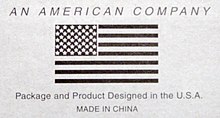
Back بلد المنشأ Arabic País de origen Spanish Pays d'origine en droit commercial French סימון מדינת מוצא HE Negara asal ID Paese di origine Italian 生産国 Japanese 원산지 Korean उत्पत्तिको प्रमाण Nepali Страна происхождения товара Russian


Country of origin (CO) represents the country or countries of manufacture, production, design, or brand origin where an article or product comes from.[1] For multinational brands, CO may include multiple countries within the value-creation process.
There are differing rules of origin under various national laws and international treaties. Country of origin labelling (COL) is also known as place-based branding, the made-in image or the "nationality bias". In some regions or industries, country of origin labelling may adopt unique local terms such as terroir used to describe wine appellations based on the specific region where grapes are grown and wine manufactured.
Place-based branding has a very ancient history. Archaeological evidence points to packaging specifying the place of manufacture dating back to some 4,000 years ago. Over time, informal labels evolved into formal, often regulated labels providing consumers with information about product quality, manufacturer name and place of origin.
- ^ Johnson, Zachary S.; Tian, Yichao; Lee, Sangwon (2016). "Country-of-origin fit: When does a discrepancy between brand origin and country of manufacture reduce consumers' product evaluations?". Journal of Brand Management. 23 (4): 403–418. doi:10.1057/bm.2016.13. S2CID 167886281.